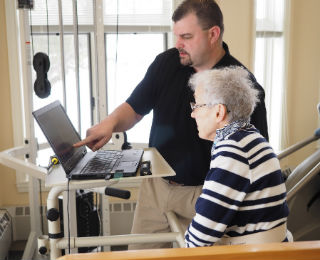Published: October 23, 2015
 A movement disorder, causing uncoordinated muscle movements of the tongue and lips, sent Kendal resident Heidi Leen to speech therapy, a service offered right on campus. It was there that Heidi learned specific techniques to combat the disorder and improve overall speech intelligibility.
A movement disorder, causing uncoordinated muscle movements of the tongue and lips, sent Kendal resident Heidi Leen to speech therapy, a service offered right on campus. It was there that Heidi learned specific techniques to combat the disorder and improve overall speech intelligibility.
For one of the sessions, Heidi brought along a couple friends so they could carry on a conversation under the guidance of Stephanie Caesar, a speech therapist and director of rehabilitation at Kendal.
“It was very helpful. I learned how to speak slowly. We should all speak as clearly as a newscaster,” says Heidi, who recently “graduated” from therapy.
All therapy at Kendal is custom-designed and one-on-one, available to both Kendal and community residents. Sessions are held in the therapy gym next to the clinic, the pool for aquatics, the fitness room for more intense strength training with advanced equipment, a smaller, more private gym in Whittier Assisted Living, and in the resident’s home.
“It is all based on the individual needs of each person,” Stephanie says.
Three Types of Therapy
Physical Therapy (PT): helps restore and maintain maximum movement and functional ability for a variety of conditions.
“When people ask me to explain physical therapy, I normally say that PT focuses on the lower body and mobility related to the lower body. For PT, residents work on muscle groups and strengthening so they can move effectively and efficiently. We recently worked with a couple of residents who were having knee problems and wanted to resume biking and tennis—and they were able to do so,” she says.
For Anne Wardwell, physical therapy helped her return to walking without a cane after hip surgery. “I first went to therapy to see if I really needed a hip replacement, and I did,” she says.
Occupational Therapy (OT): focuses on quality of life. It helps people adapt to life changes caused by illness or injury, and improve their functional abilities related to bathing, dressing, grooming, cooking, cleaning and other household chores.
“OT focuses on upper body and tasks that require use of your upper body. Therapy can address pain or strengthening for your fingers, hands and arms in order to write, brush your teeth and hair, wash your face and body, fasten buttons, open cans, twist caps, and so on,” Stephanie explains. “There’s really no limit to what therapy can help you accomplish.”
There are also many inexpensive tools available that can assist with recovery.
Speech Therapy: helps improve cognitive aspects of communication, including listening, reading, writing and language interpretation.
“Most people think of speech therapy as helping people speak, but it really is much more than that. We can address memory, functional problem-solving such as paying bills, operating a DVD player, reading a map, and following a recipe, as well as safety awareness and swallowing,” Stephanie says.
And There’s Usually Homework
Heidi was assigned a home exercise program that included reading sentences aloud and repeating drill words in order to master the techniques.
“It would be very rare to come see us and not get an individualized home exercise program,” Stephanie says.
People often struggle with pain, lack of motivation, boredom, depression and confusion when going through rehabilitation, but therapy can help. “When you come to therapy, you’re getting a partner for this process that can be so difficult. Your therapist is your coach, your cheerleader and your friend all in one,” Stephanie says.
Along with having a more positive outlook and a higher tolerance for pain, family support can also be an asset, Stephanie says.
That was certainly the case for Anne. “There was nothing my husband won’t do – cooking, laundry, grocery shopping. I was supposed to keep moving and he would take walks with me,” she says.
 Written By: Molly Kavanaugh
Written By: Molly Kavanaugh





